Sub-Oceanic Volcanic Activity ANSYS Fluent Training
$180.00 Student Discount
- The problem numerically simulates the Sub-Oceanic Volcanic Activity using ANSYS Fluent software.
- We design the 2-D model by the Design Modeler software.
- We mesh the model with ANSYS Meshing software, and the element number equals 42,751.
- We perform this simulation as unsteady (Transient).
- The multiphase VOF model is used to model the three phases of air, water and vapor.
- Evaporation and condensation is used for mass transfer mechanism.
To Order Your Project or benefit from a CFD consultation, contact our experts via email ([email protected]), online support tab, or WhatsApp at +44 7443 197273.
There are some Free Products to check our service quality.
If you want the training video in another language instead of English, ask it via [email protected] after you buy the product.
Description
Description
The present project investigates the volcanic activity under the oceans. The eruptions occurring under the water surface can have various applications in oceanography and ocean engineering. Predicting the oceans’ behavior can be of great importance. Predicting the oceans’ behavior under such extreme conditions can provide huge data for meteorological, and weather forecasting sciences while preventing natural disasters such as tsunami.
This product is the third chapter of the VOF Multiphase Model Training Course.
The geometry is designed in ANSYS Design Modeler software. In addition, an unstructured mesh grid is generated using ANSYS Meshing software. As a result, 42,751 cells were generated.
Sub-Oceanic Volcanic Activity Methodology
In this project, the multiphase VOF model has been used to model an ocean under which multiple volcanos are erupting. Open channel flow along with Open channel wave boundary submodel is enabled to model the waves moving on the surface of water by enabling shallow/intermediate waves submodel.
One type of wave has been introduced into the domain using fifth order stokes wave theory. Evaporation and condensation mass transfer using Lee model is also enabled to predict the volume of vapor generated to due immense temperatures that occur on the time of volcanic eruption and the hydrodynamic effects of such eruptions and vapor generation is investigated over the oceans’ wave pattern.
Conclusion
In this project, the interactions between the volcanic activity under the ocean’s surface with the passing waves over the water surface has been examined. It is shown that the dynamics of the vaporized water influence the hydrodynamic of existing waves and disrupt their pattern.
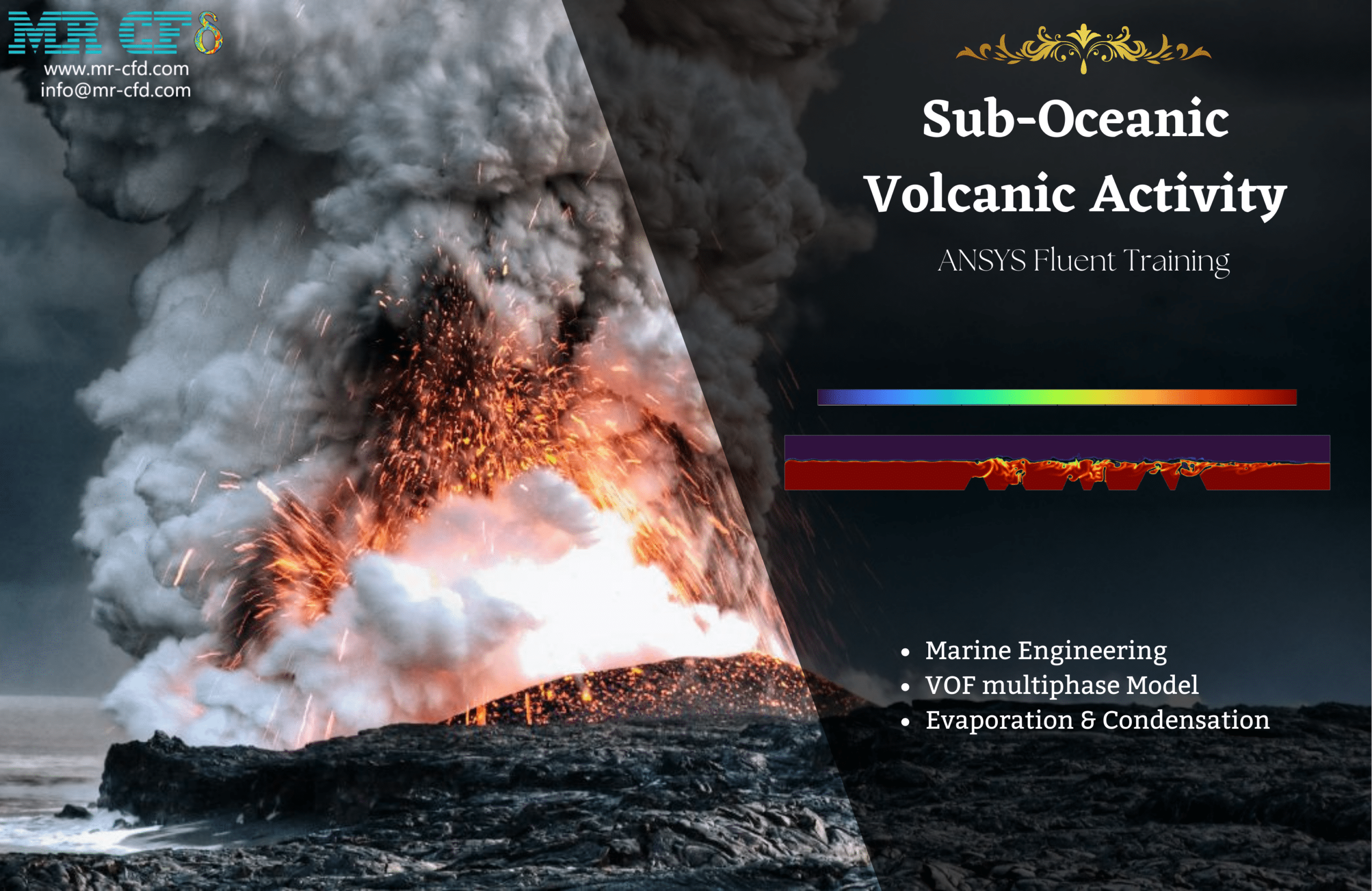

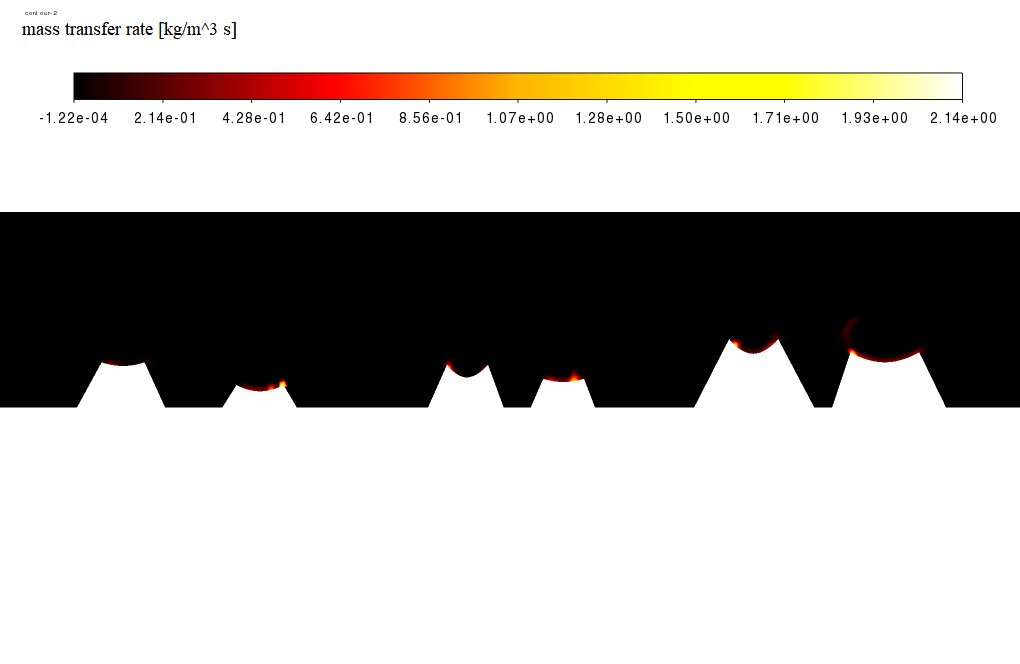

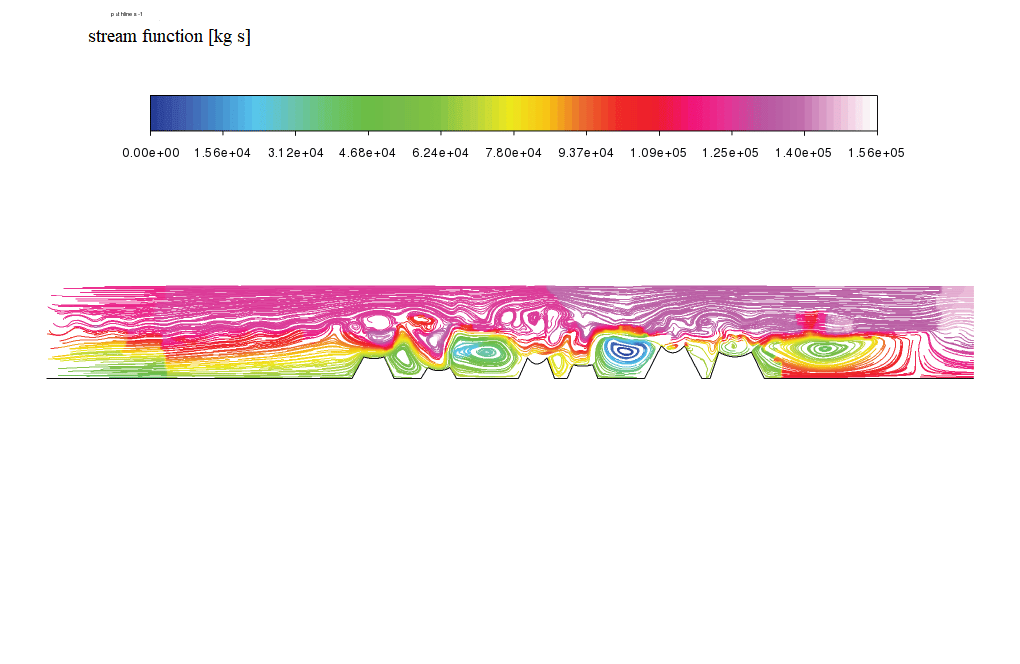
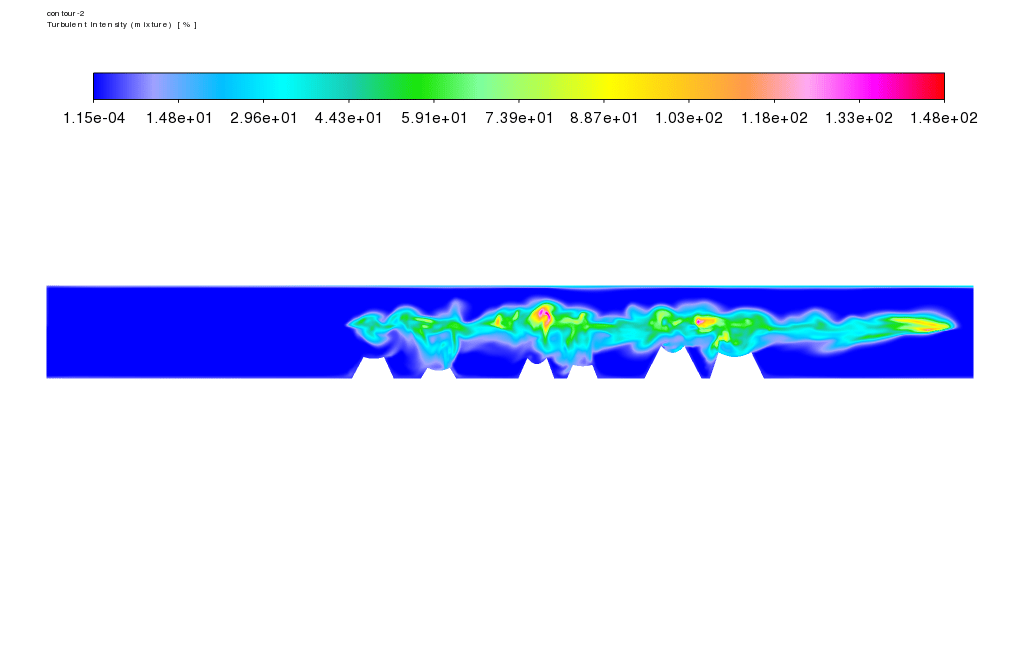
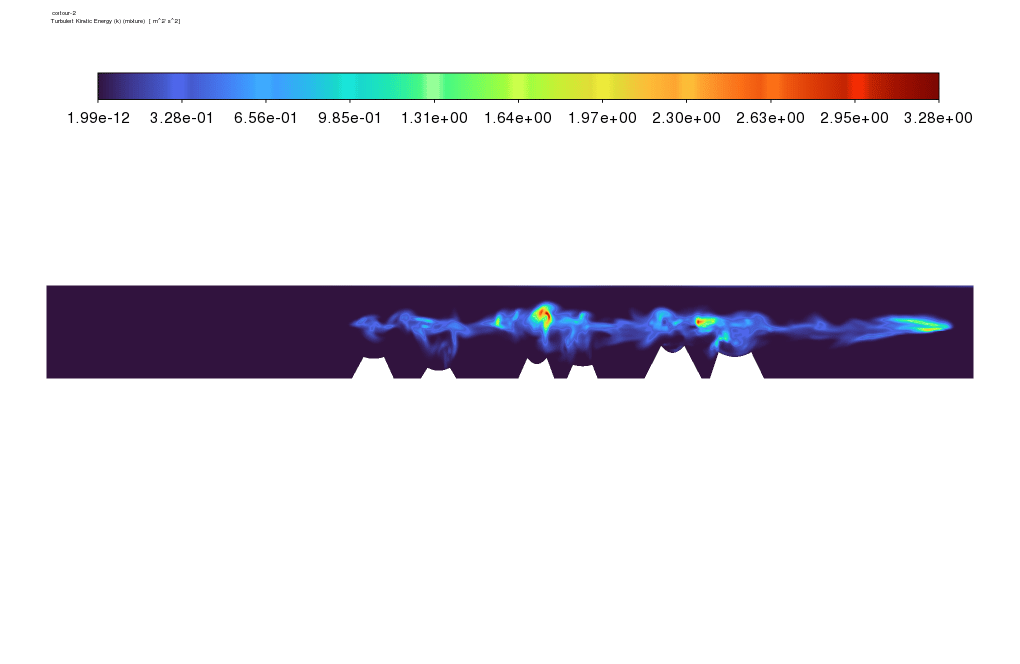
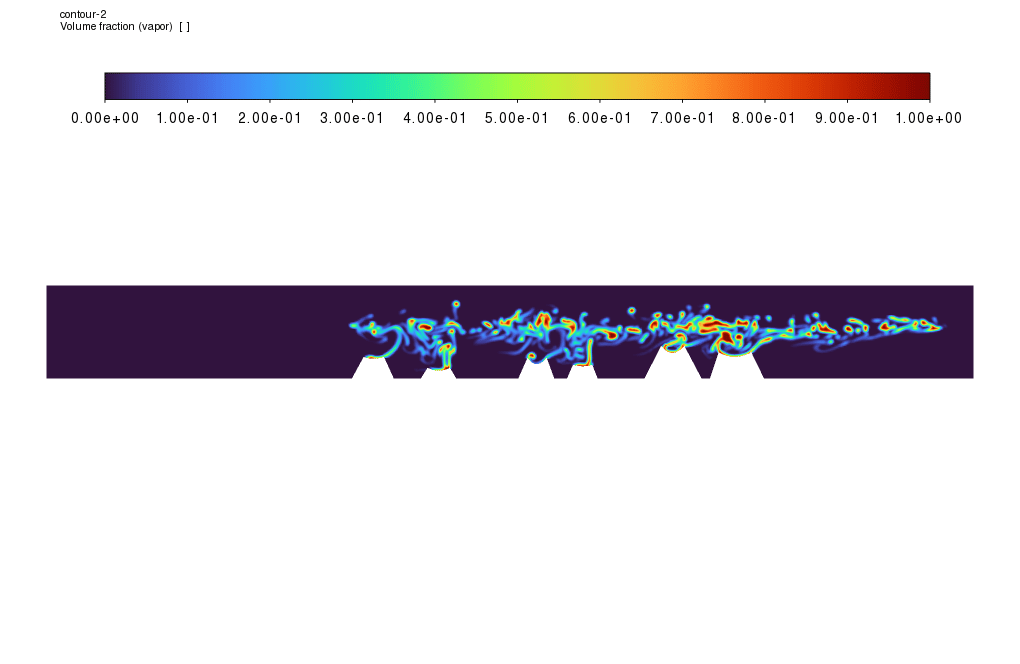
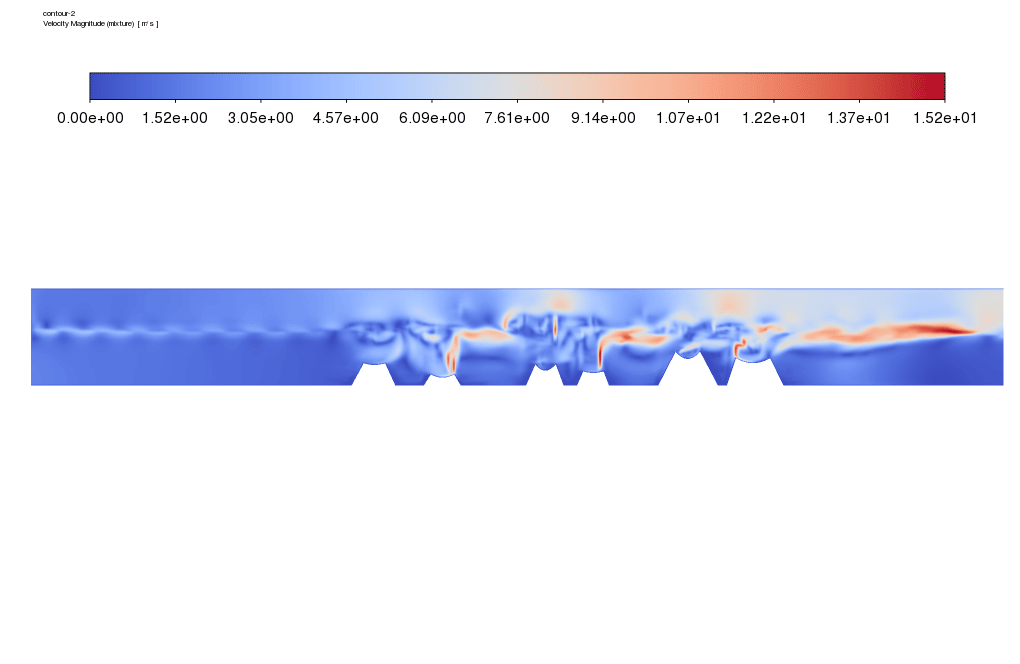
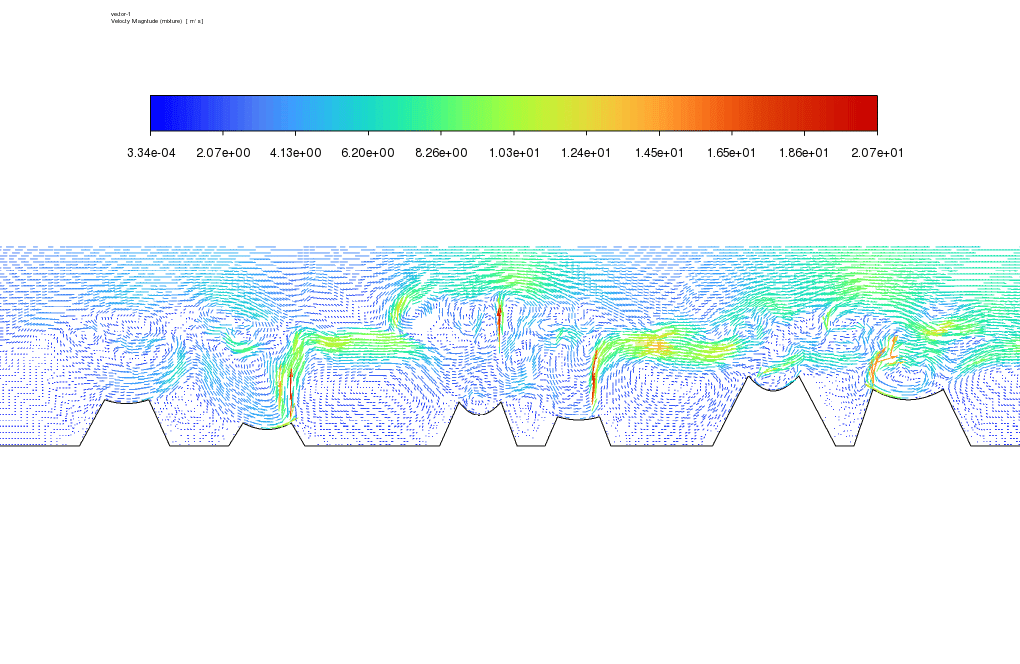
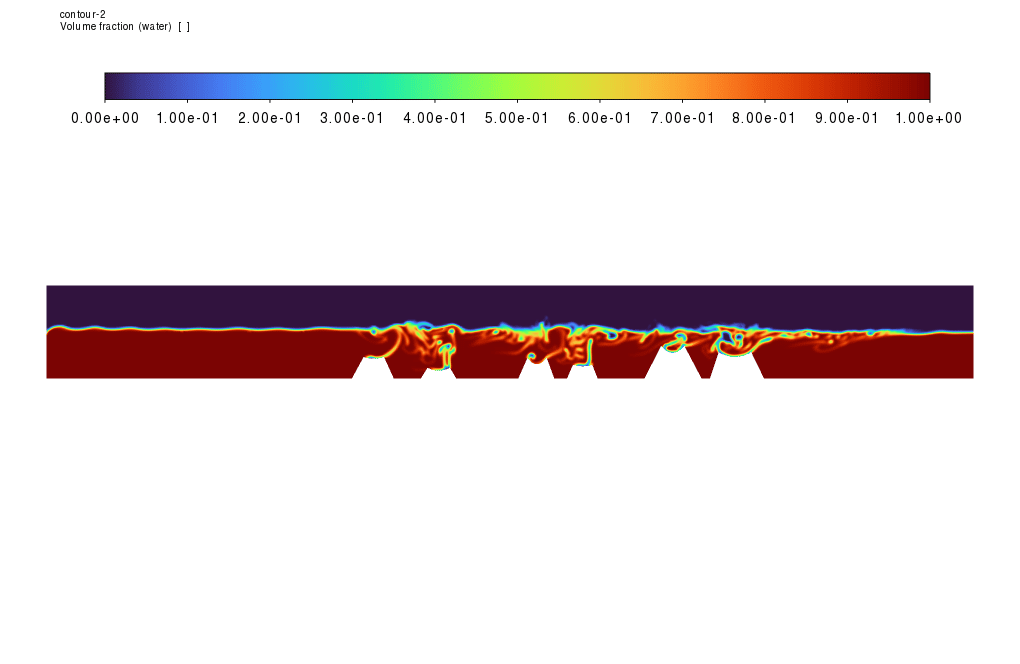
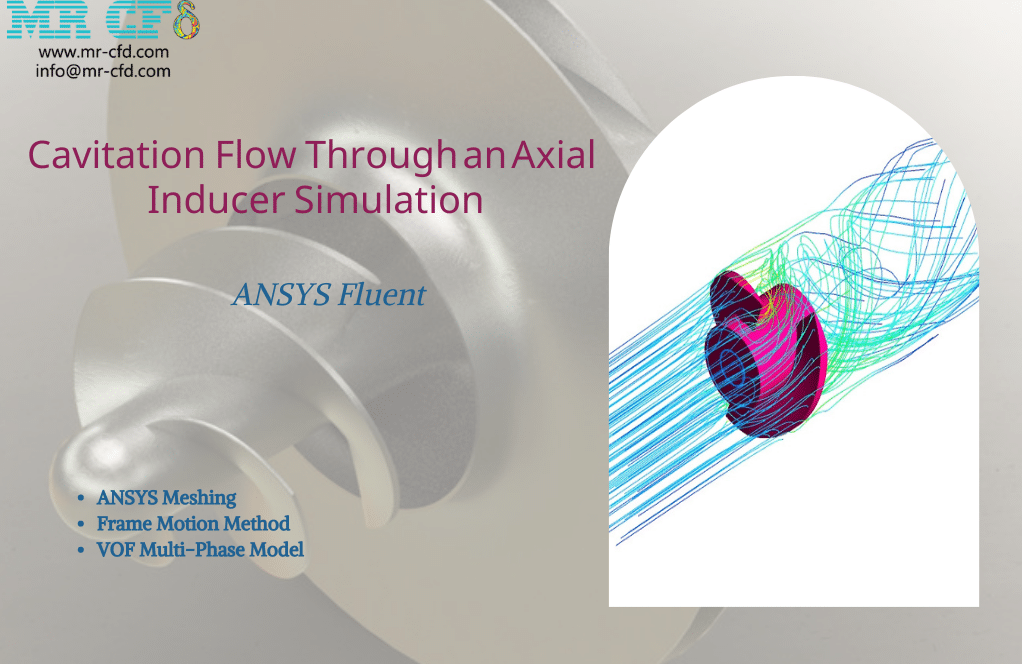


Ms. Janie Lueilwitz II –
I just finished going through the ‘Sub-Oceanic Volcanic Activity ANSYS Fluent Training,’ and I must say, the level of detail when it comes to simulating the interactions of the volcanic activity with the ocean’s dynamics was impressive. The multiphase VOF model application was well explained and provided great insights into oceanography applications. Thank you for such an informative chapter in the VOF Multiphase Model Training Course.
MR CFD Support –
We’re thrilled to hear that you found the ‘Sub-Oceanic Volcanic Activity ANSYS Fluent Training’ so beneficial and informative! Understanding these complex interactions is crucial for a wide range of scientific and engineering applications, and we’re glad you appreciate the depth of detail provided. Thank you for your positive feedback, and we are here to support your continued learning journey!
Myrl Lowe IV –
I’m thrilled with the complexity of this simulation! Do the results reflect what happens in real sub-oceanic volcanic activities?
MR CFD Support –
Thank you for your kind words! Yes, the simulation has been carefully structured to mimic real-life sub-oceanic volcanic eruptions. The interactions between the volcanic activity and the ocean waves, as well as the dispersion of vapor, are modeled to provide an accurate representation of the actual phenomena. The goal of the simulation is to provide insights that are as close to real oceanic conditions as possible, offering meaningful data for further study and application in oceanography and natural disaster prediction.
Lysanne Schaefer –
The visualization of volcanic activity in the underwater simulations must be quite captivating. Would you be able to share if the project includes animation of the waves and the eruptions?
MR CFD Support –
We’re thrilled you found the subject intriguing! And yes, the project includes dynamic animations showcasing the interaction between the erupting volcanoes and the ocean waves. These visual aids help in understanding the complex behavior of the multiphase fluid dynamics.
Robert Ebert –
The course sounds incredibly detailed and insightful! I was wondering, is there an example of troubleshooting complex simulations that might occur due to the multiphase interactions and extreme conditions described?
MR CFD Support –
In our training, we indeed cover complex simulation challenges that learners may encounter due to intricate multiphase interactions and extreme environmental conditions. Case studies and troubleshooting strategies for maintaining numerical stability and ensuring physical accuracy are integral parts of the curriculum.
Dr. Lavern Schmeler –
The simulations display an excellent grasp on deep ocean dynamics due to volcanic activity. I have gained valuable insights into the metamorphic processes that could potentially forecast oceanic transformations and their surface impact.
MR CFD Support –
Thank you for your positive feedback. We’re glad to know that the simulation has provided valuable insights and increased your understanding of ocean dynamics related to volcanic activities. If there’s anything further you’re curious to explore or if you have any more feedback, we’re here to listen and assist!
Kellie Roberts –
I’m amazed by the complexity of modeling both the volcanic activity and its interaction with ocean waves. How accurately does the simulated disruption of the wave pattern reflect real-world scenarios, especially concerning the prevention of natural disasters like tsunamis?
MR CFD Support –
Thank you for your positive feedback! The accuracy of the simulated disruption in this training module is subject to several factors, including the precision of the initial conditions, the computational resources, and the modeling assumptions made during the setup. The model uses sophisticated techniques like the VOF multiphase model and open channel wave boundary submodels to simulate real-world behaviors. These methods are a robust attempt to mimic actual oceanic responses to volcanic activity, aiding in predicting potential tsunami events. However, validation with real-world data is essential to ensure the model’s reliability for disaster prevention purposes.
Sylvan Stanton –
Just wanted to let you know that your training material for sub-oceanic volcanic activity was fascinating. The detailed explanation of the VOF model inside ANSYS Fluent made it easier to understand such complex phenomena. Keep up the excellent work on these educational resources!
MR CFD Support –
Thank you for your kind words! We’re delighted to hear that our training material was helpful to you and that you found the explanation of the VOF model clear and informative. It’s great to know that our efforts in creating these resources are appreciated. If you have any further questions or ever need more assistance, don’t hesitate to reach out. Thanks again for your support!
Miss Jany Collier –
I have just completed the Sub-Oceanic Volcanic Activity ANSYS Fluent Training Course. The methodologies applied are impressively accurate and signal proficiency to model such complex phenomena. The clear representation of the multiphase flow and the effects of volcanic eruptions beneath the sea on wave patterns have extensively enhanced my understanding of oceanic behavior during such events. A fantastic resource for anyone interested in oceanography or volcanic activity simulation.
MR CFD Support –
Thank you very much for the positive feedback on the Sub-Oceanic Volcanic Activity ANSYS Fluent Training Course. We’re thrilled to hear that the course has enhanced your understanding and met your expectations. Your enthusiasm for the quality of our training validates the efforts we put into creating informative and effective learning materials. We are always here to support your journey in learning about computational fluid dynamics and its applications in challenging environments like deep oceanic phenomena.
Lolita Bernier –
I just completed the ‘Sub-Oceanic Volcanic Activity ANSYS Fluent Training’ and found the application of the VOF Multiphase Model to be fascinating. The interplay between the volcanic eruptions and the ocean waves was well demonstrated. The visuals presented moving waves captured by the fifth order stokes wave theory provided me with a deep understanding of the concepts. Excellent training module!
MR CFD Support –
We’re thrilled to hear that you found the ‘Sub-Oceanic Volcanic Activity ANSYS Fluent Training’ helpful and enlightening! We aim to provide high-quality training that offers practical insights into complex phenomena using ANSYS Fluent. Your positive feedback is very much appreciated, and we’re glad that our visual examples greatly facilitated your learning. Thank you for choosing our product, and we look forward to providing you with more valuable learning experiences in the future!
Prof. Gregg Leffler –
I’m impressed with the detailed modeling of underwater volcanic activity. The simulation seems to handle complex interactions between the eruptions and ocean waves expertly. Can you tell me which specific features or data in the results I should look at to better understand the impact of eruptions on wave patterns?
MR CFD Support –
Key features and data to focus on in the simulation results to understand the impact of eruptions on wave patterns include the disruption of wave continuity, changes in wave amplitude and frequency, and alterations in flow patterns around the eruption area. Look for changes in the velocity fields, pressure contours, and volume fraction contours of the vaporized water to gauge the hydrodynamic effects. Evaluating such results helps determine how volcanic activities can modify oceanic wave behavior.
Kaylie Herzog –
I’m impressed by the comprehensive study of sub-oceanic volcanic activity and its impacts on ocean hydrodynamics using ANSYS Fluent. Your methodology for capturing the complex multiphase interactions is insightful.
MR CFD Support –
Thank you for your kind words regarding our Sub-Oceanic Volcanic Activity ANSYS Fluent Training. We are pleased to know that you found the study comprehensive and insightful. We strive to deliver detailed and high-quality simulations to aid in understanding natural phenomena. Appreciating our methodology encourages us to continue providing top-notch educational material. If you need further assistance or have any more questions, please feel free to reach out.
Prof. Alexandre Little –
Is this simulation capable of giving insights for tsunami prediction associated with submarine volcanic eruptions?
MR CFD Support –
Yes, the simulation is capable of providing insights into tsunami prediction as it investigates the hydrodynamic effects of volcanic activity under the ocean’s surface, which can influence wave patterns. The interactions modeled can help understand the disturbances that may lead to tsunami generation.
Jadyn Abernathy –
This training on simulating sub-oceanic volcanic activity sounds fascinating! Did this module cover how to interpret the impact of eruptions on sea life and the surrounding environment?
MR CFD Support –
The primary focus of this training is on the hydrodynamic effects of volcanic activity under ocean surfaces, particularly on ocean waves. While the training provides detailed insights into vapor generation and interactions with wave patterns, the ecological impact on sea life and the environment is not covered in detail as it would require a biological and environmental analysis beyond the scope of this CFD model.
Theresia Grant –
Fantastic learning resource! The coupling of VOF multiphase model with the stokes wave theory for sub-oceanic volcanic activity offered a comprehensive understanding of complex underwater phenomena. The project delicately balances both oceanographic and geological aspects of the simulation, providing insights into the hydrodynamics of underwater eruptions. Exceptional detail on the interactions between eruption dynamics and wave patterns!
MR CFD Support –
We’re thrilled you found our Sub-Oceanic Volcanic Activity ANSYS Fluent Training to be informative and detailed. Thank you for acknowledging the depth and breadth of the simulation features provided. We always strive to deliver comprehensive and instructive products. Your feedback is greatly appreciated!
Rosalia Moen –
What an engaging learning experience the Sub-Oceanic Volcanic Activity ANSYS Fluent Training provided! The tandem evaluation of underwater volcanic eruptions and ocean wave dynamics simulates a fascinating aspect of oceanography. I appreciate how your comprehensive methodology incorporates the VOF multiphase model and open channel wave techniques, harmoniously combining volcanic activity with oceanic behaviors in the analysis. The inclusion of evaporation and condensation processes, along with the Lee model, also offered insightful perspectives on how vapor affects wave hydrodynamics amidst volcanic interactions. A top-notch educational product for understanding complex marine phenomena!
MR CFD Support –
Thank you for sharing your positive feedback on our Sub-Oceanic Volcanic Activity ANSYS Fluent Training course. We are thrilled to hear that you found the content comprehensive and educational. It is great to know that our approach to demonstrating the complex interactions between underwater volcanic activity and oceanic wave dynamics through the VOF multiphase model and advanced simulation techniques met your learning needs. We appreciate your recognition of the importance of including evaporation and condensation process modeling in the training. Your thoughts encourage us to continue delivering high-quality educational materials. Keep exploring and learning!
Dr. Haskell Dickens –
I’m impressed with the course on Sub-Oceanic Volcanic Activity and how it applies the VOF Multiphase Model in ANSYS Fluent. Understanding ocean behaviors in such extreme conditions adds significant value to ocean engineering and disaster prevention. I appreciate the complex modeling of eruptions and their impact on ocean wave dynamics, showcasing the versatility of computational fluid dynamics tools in addressing real-world problems.
MR CFD Support –
We are thrilled to hear that you found the Sub-Oceanic Volcanic Activity chapter of our VOF Multiphase Model Training Course insightful and practical. Your understanding of its application in predicting the ocean’s behavior during volcanic activities demonstrates the successful achievement of our course’s objective. Thank you for appreciating the complexity and real-world applicability of our CFD models. Your feedback encourages us to continue providing high-quality training to our learners.
Rick Kuphal –
What a fascinating presentation of sub-oceanic volcanic activity simulation! The interplay between volcanic eruptions and their influence on ocean wave patterns is truly intriguing. Implementing the VOF multiphase model to predict the dynamics of waves and vaporized water interaction provides invaluable insights. Loved how the fifth-order Stokes wave theory is introduced, highlighting advanced methodology at play. Thank you for a great learning experience!
MR CFD Support –
We’re thrilled to hear that the Sub-Oceanic Volcanic Activity ANSYS Fluent Training was informative and engaging for you! It’s always rewarding to see our customers appreciating the detailed methodology and complex scenarios our simulations are able to recreate. Thank you for your complement – we aim to provide valuable and impactful educational resources for oceanography, and your feedback is a delightful affirmation of our efforts.
Linda Zulauf –
The tutorial is fantastic, but could you clarify which specific wave phenomenon is best modelled by the fifth order stokes wave theory used in this training?
MR CFD Support –
The fifth order stokes wave theory is ideal for modelling non-linear and highly accurate waves with large amplitudes relative to the water depth, such as the complex wave patterns that might occur in the ocean atop a sub-oceanic volcanic eruption. It captures the interactions and distortions of wave shapes effectively in these scenarios.
Demetrius Hegmann II –
Can you explain how the volcanic eruption’s thermal effects were accounted for in the simulation model?
MR CFD Support –
The thermal effects of the volcanic eruption were addressed within the simulation by leveraging the Evaporation and Condensation mass transfer via the Lee model. This helps in accurately predicting the volume of vapor generated due to the extreme heat of the eruption; the effects on the temperature distribution throughout the simulated ocean water are thus considered in the analysis of hydrodynamics changes due to the eruption.
Marta Reynolds –
The course mentions using fifth order stokes wave theory for wave modeling. Can you explain a bit more about how this level of detail affects the simulation results compared to simpler wave models?
MR CFD Support –
The fifth order Stokes wave theory allows for a more accurate representation of the wave crests and troths, rather than just a sinusoidal wave. This increased detail allows for more precise simulation of wave-structure interactions, capturing complex phenomena that might occur during volcanic eruptions under the ocean.
Miss Rhianna Shields V –
Which type of waves did you introduce in the domain using the fifth order stokes wave theory?
MR CFD Support –
In the Sub-Oceanic Volcanic Activity training module, the fifth order Stokes wave theory is used to introduce shallow/intermediate depth waves into the computational domain, which allows for the examination of wave dynamics as they interact with the effects of sub-oceanic volcanic activity.
Ms. Sierra Mills –
I am very impressed by your handling of complex multiphase phenomena in the Sub-Oceanic Volcanic Activity ANSYS Fluent Training. The practical applications of predicting ocean behavior under such extremes are quite remarkable. Your training product must contribute greatly to oceanography and disaster mitigation,
MR CFD Support –
We deeply appreciate your positive feedback on our Sub-Oceanic Volcanic Activity ANSYS Fluent Training. We’re glad to hear that our course has met your expectations and that you recognize its value in significant applications such as oceanography and disaster prevention. Thank you for choosing MR CFD for your learning journey in CFD analysis!
Gabriel Franecki DDS –
I’m genuinely amazed by the application of the VOF Multiphase Model in understanding sub-oceanic volcanic activity. The in-depth analysis of ocean waves under such extreme conditions is remarkable. Huge compliments to the MR CFD Company for creating a training product that goes into the complexities of ocean behavior under volcanic activities and the detailed use of simulation in natural disaster prevention.
MR CFD Support –
Thank you so much for your kind words! We’re delighted to hear that you found the training on sub-oceanic volcanic activity to be thorough and valuable. At MR CFD, we are always committed to providing comprehensive educational materials that help our users understand and predict complex natural phenomena. Your feedback is greatly appreciated and motivates us to keep offering high-quality CFD training courses.
Briana Rice –
Great product! I learned a lot about sub-oceanic volcanic activity and its impact on ocean behavior. The use of the VOF model for demonstrating the interaction between waves and volcanic eruptions was particularly insightful.
MR CFD Support –
We’re so glad to hear you found the training helpful and informative! Understanding the complex interactions under the ocean surface is crucial, and we’re happy our product could enhance your knowledge. Thanks for your feedback!
Hermann Conn PhD –
Are both the effects of eruption-induced temperature changes and mass transfer of vapor considered in the solution of this problem?
MR CFD Support –
Yes, the simulation considers both the effects of eruption-induced temperature changes and the mass transfer of vapor. These parameters are crucial for accurately depicting the physics of under-ocean volcanic activity and its impact on ocean waves and overall oceanography.
Eric Fritsch –
What kind of waves did the simulation recreate using the fifth order Stokes wave theory in regards to volcanic eruptions? Were these attempting to replicate certain real-world conditions?
MR CFD Support –
In this simulation, the fifth order Stokes wave theory is used to introduce complex ocean waves that interact with eruptive forces from underwater volcanoes. This theory enables the recreation of realistic ocean wave conditions that would be influenced by sub-oceanic volcanic activity. The simulation is likely trying to mimic scenarios that are encountered in the real ocean, where volcanic activity can indeed affect wave patterns.
Raina Howell –
Outstanding work on the Sub-Oceanic Volcanic Activity tutorial! It’s fantastic to see how the interactions between sub-oceanic eruptions and wave patterns are examined. This subject is both complex and fascinating, and the methodology seems meticulously implemented.
MR CFD Support –
Thank you so much for your kind words! We’re thrilled to hear you found the Sub-Oceanic Volcanic Activity tutorial insightful and intriguing. Our aim is to provide detailed and clear insights into complex behaviors like these and we are glad you found the methodology well-executed. Your feedback motivates us to continue delivering quality educational content. Keep exploring and happy learning!
Prof. Kari Murray –
I just finished the Sub-Oceanic Volcanic Activity ANSYS Fluent training, and I was shocked by how much I learned. The way that the VOF Multiphase Model was used to simulate volcanic eruption under the ocean was incredibly detailed. The open channel flow techniques, along with the mass transfer models, were particularly impressive. Watching the vapor behavior affecting ocean waves provided an excellent visual understanding of volcanic activity’s impact on ocean hydrodynamics. Looking forward to applying this new knowledge in my field of work!
MR CFD Support –
Thank you so much for your positive feedback! We’re thrilled to hear that you found the Sub-Oceanic Volcanic Activity ANSYS Fluent training informative and engaging. It’s great to know that the course could provide you with insights that will be valuable in your professional endeavors. Your enthusiasm for the subject matter is exactly what we strive to inspire in our learners. If you ever have more questions or need further assistance as you apply what you’ve learned, don’t hesitate to reach out. Best of luck with your future projects!
Prof. Henri Pagac –
Your CFD training on sub-oceanic volcanic activity really helped me improve my understanding of ocean waves interaction with volcanic eruptions. The utilization of the VOF Multiphase Model in such complex simulations is impressive!
MR CFD Support –
Thank you for your kind words! We’re delighted to hear that our training course on sub-oceanic volcanic activity has enhanced your understanding of complex ocean interactions. Your feedback is much appreciated!
Alize Mueller –
Wow, this project on sub-oceanic volcanic activity using ANSYS Fluent sounds remarkable! It’s incredible how it contributes to understanding ocean behavior under such extreme natural occurrences.
MR CFD Support –
Thank you so much for your positive feedback! We’re glad to hear that the project on sub-oceanic volcanic activity has impressed you. It’s a fascinating subject, and we’re pleased to provide educational material that can contribute to the field of oceanography and natural disaster prevention. Don’t hesitate to reach out to us for more information or assistance in your learning journey!